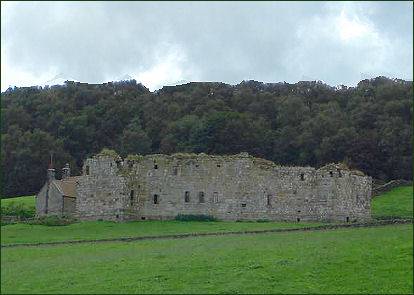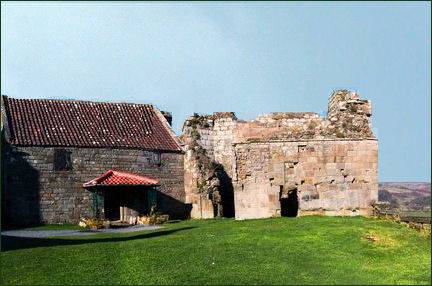Danby Castle
OS grid reference:- NZ 717 073
 Medieval Danby Castle in the North York Moors National Park stands on a moorland spur overlooking the valley of the River Esk in the North York Moors National Park.
Medieval Danby Castle in the North York Moors National Park stands on a moorland spur overlooking the valley of the River Esk in the North York Moors National Park.
The castle was constructed in the fourteenth century by the Latimer family, whose members included some of the most powerful nobles of medieval England. It was built to replace an earlier castle at Castleton which was destroyed by fire. It is believed that some of the stone was used to build Danby Castle. If this is correct then this early fourteenth century heraldry may have been brought to Danby with the building stone. Danby is a quadrangular castle, essentially a rectangular building with a central courtyard and towers at each corner. This type of castle was quite common in the north of England at the end of the fourteenth century.
 When the Latimer family became extinct in the male line at the end of the fourteenth century, the estate passed to the powerful Neville family, descendants of Elizabeth Latimer, who had married John, 3rd Baron Neville of Raby, who fought against the Scots at the Battle of Neville's Cross on 17 October 1346. The Neville Arms are still to be seen on the south wall of the Courtroom.
When the Latimer family became extinct in the male line at the end of the fourteenth century, the estate passed to the powerful Neville family, descendants of Elizabeth Latimer, who had married John, 3rd Baron Neville of Raby, who fought against the Scots at the Battle of Neville's Cross on 17 October 1346. The Neville Arms are still to be seen on the south wall of the Courtroom.
John Neville died seven years later, leaving Elizabeth in control of the estates until her own death in 1396. The estate was then passed to her son, another John. who took control of his estates on his came of age in 1400. John Neville was not his father's oldest son, as this was Ralph Neville, some thirty years old than John, who became Earl of Westmorland in 1397. To mark the establishment of his own family, John soon took the title of 6th Baron Latimer.
. In the sixteenth century John Neville, Lord Latimer, (1493-1543), who owned Danby Estate, married Catherine Parr (right) as his third wife and their marital home was Danby Castle. John Neville was a cousin of the famous Richard Neville, known as 'Warwick the Kingmaker'. He served in King Henry VIII's French campaign, and was knighted after the capture of Tournai in 1513, he was appointed to the office of gentlemen-pensioner to Henry VIII. In 1536 he was implicated in the Pilgrimage of Grace, in an ambivalent role. It was rumoured that he was captured by the rebels, and he afterwards said of the part he had played: "My being among them was a very painful and dangerous time to me". He represented the insurgents, however, in November 1536 at the conferences with the royal leaders, and helped to secure the amnesty. After Neville's death Catherine Parr became the sixth and final wife of King Henry VIII, fortunately, Catherine survived her formidable spouse and went on to marry again .
 The South Range of the Castle was converted into a manorial Courthouse with the former private chamber being divided into a Court Room. Danby Castle now stands partly in ruins, but is still the venue for the Danby Court Leet, which meets in October. It is reputed to be one of the earliest examples of a fortified but principally domestic castle. Three of the four towers still exist in some form, the two northern towers as ruins, the south-eastern as part of the modern farmhouse. The south wing also survives intact.
The South Range of the Castle was converted into a manorial Courthouse with the former private chamber being divided into a Court Room. Danby Castle now stands partly in ruins, but is still the venue for the Danby Court Leet, which meets in October. It is reputed to be one of the earliest examples of a fortified but principally domestic castle. Three of the four towers still exist in some form, the two northern towers as ruins, the south-eastern as part of the modern farmhouse. The south wing also survives intact.
Later in the same century the Estate passed to the Danvers family and Sir Henry Danvers was created Earl of Danby. In the seventeenth century Danby was purchased by John Dawnay, who was later created Viscount Downe. The Estate has remained with the Dawnay family ever since.
The South-East tower of the old mansion still remains, a farm house and farm buildings were added. Repairs were made in the nineteenth century and the South Range was restored circa 1960. Down in the dale stands the estate’s former hunting lodge, now the Moors National Park Centre.
The Count Leet Rooms and can be hired for private dinners, functions and weddings . Visitors can view the castle by arrangement with the Tenant.
Historic Buildings of Yorkshire
